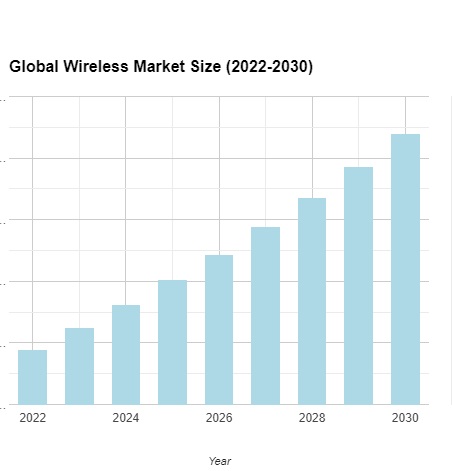Introduction:
The Wireless Market, a vital force in our connected world, is the subject of our in-depth market research analysis. In this article, we delve into the market's size, growth trajectory, key players, emerging trends, and future outlook, providing valuable insights for businesses and investors navigating this dynamic landscape.
Global Wireless Market Size and Growth Trajectory:
The Global Wireless Market stands at an impressive USD 1.7 trillion in 2023, with experts forecasting a robust CAGR of 6.3% from 2024 to 2030. This trajectory is expected to propel the market to an astounding USD 2.6 trillion by 2030. The growth is fueled by various factors, including:
- Exponential Smartphone Penetration: The demand for wireless services rises in tandem with the adoption of smartphones, with over 6.6 billion users globally.
- 5G Revolution: The deployment of 5G networks, providing faster speeds, lower latency, and enhanced capacity, is a key driver, fostering innovation and new applications.
- Internet of Things (IoT) Boom: The increasing connectivity of everyday devices generates substantial demand for reliable and efficient wireless infrastructure.
- Rising Mobile Data Consumption: Our insatiable appetite for online content and streaming services necessitates higher bandwidth and robust wireless networks.

Wireless Market Share and Top Players:
The Wireless Market comprises a diverse ecosystem with various players across different segments. Key contenders include:
- Mobile Network Operators (MNOs): Dominant players such as Verizon, AT&T, China Mobile, and Vodafone offer cellular voice and data services to consumers and businesses.
- Telecom Equipment Manufacturers (TEMs): Companies like Huawei, Ericsson, Nokia, and ZTE play a crucial role in developing and supplying the infrastructure powering wireless networks.
- Over-the-Top (OTT) Content Providers: Giants like Netflix, YouTube, and Spotify rely on robust wireless networks to deliver content to users.
Niche players focusing on specific technologies, such as satellite communication or private LTE networks, are also emerging, adding dynamism to the market.
Wireless Industry Trends and Opportunities:
The Wireless Industry is in a constant state of evolution, presenting exciting opportunities for businesses and investors. Key trends include:
- Network Virtualization: The adoption of Software-Defined Networking (SDN) and Network Function Virtualization (NFV) optimizes network management, leading to increased efficiency and agility.
- Edge Computing: Processing data closer to its source reduces latency and improves network performance, particularly for time-sensitive applications like augmented reality (AR) and virtual reality (VR).
- Network Slicing: Operators can create virtual networks with specific characteristics, catering to diverse needs like low latency for IoT or high bandwidth for video streaming.
- Open RAN: The adoption of open interfaces in radio access networks fosters innovation and competition, potentially reducing costs and accelerating technology development.
Businesses can capitalize on these trends to develop innovative solutions and tap into lucrative new markets.
Wireless Market Research Reports for Strategic Insights:
Navigating the dynamic Wireless Industry requires access to reliable data and expert analysis. Reputable market research providers include:
- Ken Research: Provides in-depth analysis of the global wireless market, including technology trends, vendor landscape, and future forecasts. Also offers reports on specific segments like 5G technology, IoT services, and mobile network infrastructure. Analyzes regional markets and provides insights into operator strategies and regulatory trends.
Investing in these reports or conducting independent research equips businesses with the knowledge to make strategic decisions and capitalize on emerging opportunities.
Wireless Industry Future Outlook: A Connected Tomorrow:
The Wireless Market future promises continued growth and innovation. Anticipated developments include:
- Wider 5G Adoption: Ubiquitous 5G networks enabling advancements in AR/VR, autonomous vehicles, and smart cities.
- Rise of Private Networks: Businesses deploying private wireless networks for enhanced security, control, and performance.
- Focus on Sustainability: The industry embracing renewable energy sources and energy-efficient technologies to reduce its environmental impact.
- Convergence of Technologies: Integration of wireless with other technologies like AI and blockchain unlocking new possibilities and applications.
This article illuminates the essential role of the Wireless Market in our connected world. By understanding its dynamics, identifying emerging trends, and leveraging research insights, businesses and individuals can contribute to shaping a more connected and innovative future.

